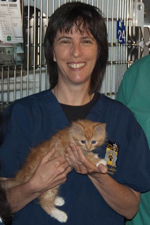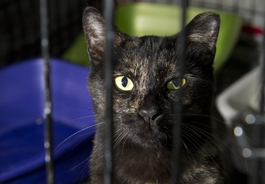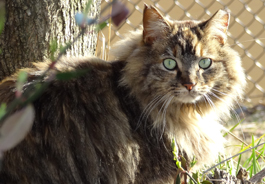|
The Humane Society Veterinary Medical Association (HSVMA) advocates for animals through legislation, publication and litigation. We strive to develop better public policies for animals and advance humane alternatives in veterinary education. |
|||||||||||||||||||||
Perhaps the greatest benefit of allowing cats to remain in communities is that it gives every community member a chance to participate in the solution. Shelters have a long history of taking this approach when it comes to wild critters such as raccoons and opossums. Realizing the futility of trying to control these species through shelter admission and euthanasia, we guide people to other solutions. The same can be true for community cats: With a little guidance, many people will rise to the occasion, and find ways to coexist peacefully with the cats in their neighborhood. Without the illusion that euthanasia can eliminate the concerns associated with cats, wildlife advocates, public health officials, and cat aficionados alike can work together to find other answers. And while there will no doubt be some relentless complainers over this idea – as there are with any new policy – some great shelter wisdom applies perfectly here: “You’ll be criticized no matter what you do. You might as well be criticized for doing the right thing.” I started this article with a reminder of what got me into this field in the first place—my love for animals. But I’ve come to realize I love people too. I love the people who do this challenging, rewarding, necessary, and sometimes heartbreaking work. I remember myself as a 24-year-old field officer, brimming with enthusiasm for my chosen profession. I think of how my heart ached for the cats we couldn’t save, and whose lives I ended with as much compassion as I knew how. I think of people still in the trenches, and I mentally multiply the number of cats euthanized by the toll each death takes on all of us. I picture the river of time, energy, space, money, and heartache our profession has poured into the seemingly unending task of sheltering and euthanizing healthy cats. Then I imagine we just stop. We don’t admit one more healthy cat to a shelter than we can release alive. And I imagine that enormous river of resources and compassion diverted to finding other solutions, to spay/neuter services, to educating the public, to caring for domestic and wild animals, to finding ways to protect all the species we treasure. I imagine you, reading this article. I wonder what your role is and what it would mean to you if we could see a day when no healthy cat was euthanized in our shelters. I hope we don’t have to wait another 20 years to find out.
 UC Davis Kate Hurley is the director of the UC Davis Koret Shelter Medicine Program. Dr. Hurley began her career as an animal control officer in 1989. After graduation from the UC Davis School of Veterinary Medicine in 1999, she worked as a shelter veterinarian in California and Wisconsin. In 2001, she returned to UC Davis to become the first in the world to undertake a residency in Shelter Medicine. Following completion of the residency, Hurley became the director of the UC Davis Koret shelter medicine program. Two of her proudest achievements are co-authoring the “Association of Shelter Veterinarians’ Guidelines for Standards of Care in Animal Shelters” and co-editing the textbook “Infectious Disease Management in Animal Shelters”. She loves all things shelter-related, but her particular interests include welfare of confined dogs and cats, humane and effective strategies to manage community cats, infectious disease, and unusually short dogs. She loves shelter work because it has the potential to improve the lives of so many animals and the people who work so hard to care for them. |
|||||||||||||||||||||
|
|||||||||||||||||||||
|
More Articles...
|
|||||||||||||||||||||
|
<< first < Prev 11 12 13 14 15 16 17 18 19 20 Next > last >> |
|||||||||||||||||||||
| Page 17 of 46 | |||||||||||||||||||||


